When you’re installing your RV or campervan electrical system, you will face the choice to wire your solar panels together in either series or parallel.
There are pros and cons to each setup, and your decision will ultimately depend on your use case. But series is typically the better choice for most DIY campervan solar power setups. If you have a larger solar array you can also employ series-parallel wiring for additional benefits.
The important difference between wiring solar panels in series vs parallel is what happens to the voltage and the current in each configuration. With series wiring voltage adds while current stays the same, whereas with parallel wiring voltage stays the same while current adds.
What does this mean and why does this matter? This article digs into the answers to these questions. We’ll go over the benefits and drawbacks of series and parallel connections for van and RV solar panels, look at some examples and use cases, and talk about what this all means for designing your off grid solar PV (photovoltaic) array.
Bottom line: Wiring your solar panels in series vs parallel is the way to go for campervan and RV solar systems. Because the voltage adds with series wiring, your solar panels will hit charging voltage much sooner in the day, meaning your batteries will charge faster and longer. Series wiring is also much simpler because you don’t need additional wiring connectors or fuses.
For larger arrays (minimum 400W, but better with 600W or more), you can use series-parallel wiring, which combines the voltage benefits of series wiring with the shading benefits of parallel wiring.
This post is adapted from our ebook Vanlife Solar Basics.
Are you tired of jumping from website to website trying to wrap your head around your van’s electrical system? Our comprehensive guide covers everything from fundamentals to components to sizing to installation, all in one easy-to-follow package.
Wiring Solar Panels in Series
To wire your solar panels in series, connect the positive terminal from one panel to the negative terminal of the next, and so on. This wiring method creates what’s called a string of solar panels.
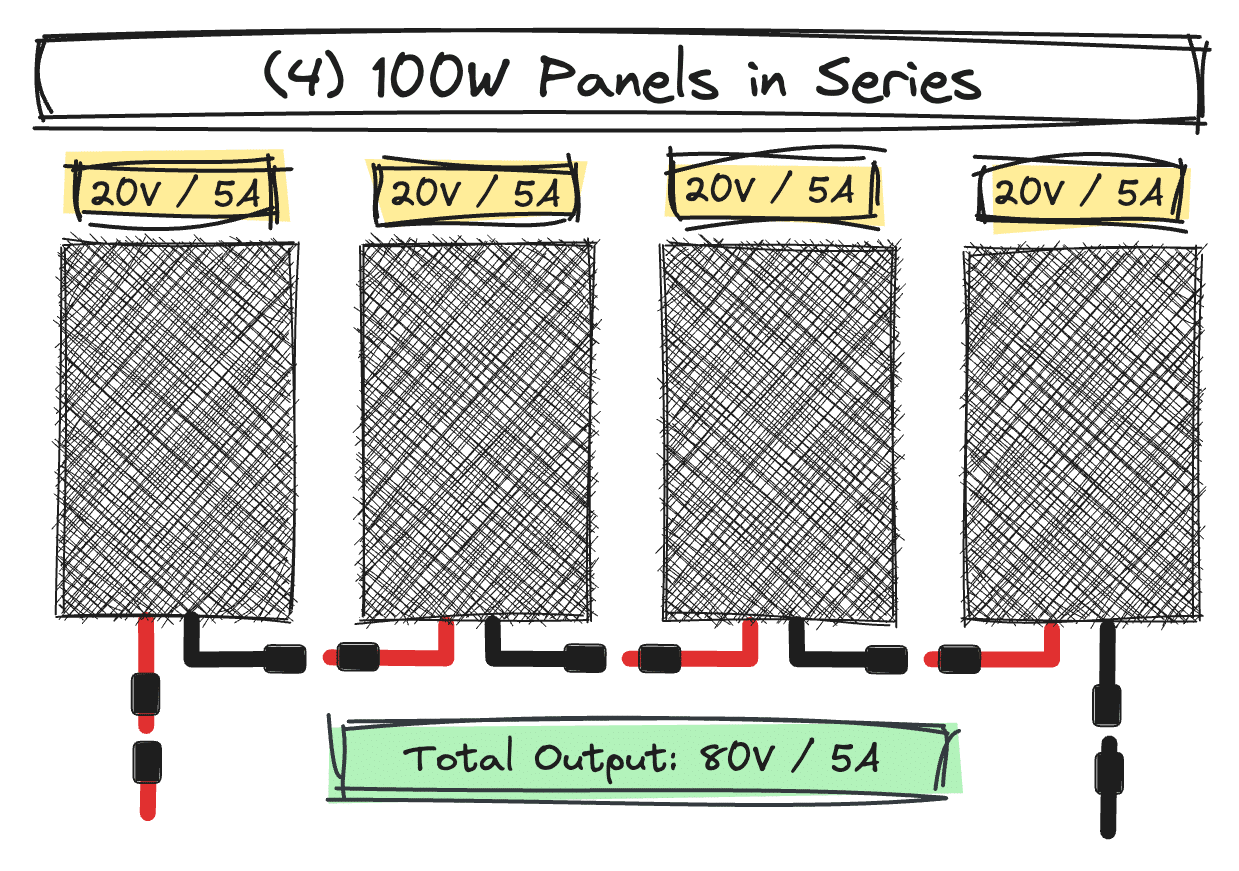
With series wiring, the voltage of the panels adds together while the amperage (current) stays the same.
Example: If you have four 100W solar panels wired in series and each panel outputs 5A at 20V, your array would output 5A at 80V (4 panels x 20V = 80V).
That 80V output is in full sun. At times of day when less sun is hitting your panels (early morning, late afternoon) or when there are clouds in the sky, the system output voltage will be substantially less.
Why does this matter? Your solar panel output voltage needs to exceed the charging voltage of your batteries before they can begin charging. Because Volts add with series wiring, the output of your PV array will hit that charging voltage much earlier in the day compared to a parallel system, and will continue charging for longer.
Where to Find the Voltage of Your Solar Panels
You have 12 Volt solar panels, so the voltage produced must be 12 Volts, right? Wrong.
12V is what’s called the nominal voltage, and is basically used for matching equipment and components together for compatibility. If you’re building a 12V electrical system, you’ll want a 12V battery bank, a 12V charge controller, 12V solar panels, and 12V inverter, for example.
The actual output voltage of your solar pv modules will be higher than the nominal voltage. 12V panels produce up to 18V-24V, depending on the panel. The figure out the maximum voltage for your specific PV panels, take a look at the open circuit voltage (voc). You can find the open circuit voltage on the specifications sticker on the back of most solar panels, in the manual, or on the manufacturer’s website.
Benefits of Series Wiring for Solar Panels
Wiring solar panels in series vs parallel has several benefits when it comes to setting up an efficient solar power system that will sustain you for life on the road.
- The major benefit to series wiring is the higher voltage it produces. Because of the higher voltage from the series connection, your batteries will ultimately charge earlier, faster, and longer. Your solar panels will be able to produce enough voltage even in poor light conditions from shade or suboptimal panel orientation towards the sun. And combined with an MPPT charge controller, this allows you to squeeze greater efficiency out of your solar panels.
- Series wiring produces less output current (Amps), meaning you can use smaller gauge wires to connect to your solar charge controller. 10AWG solar wire is usually all you’ll need.
- Series connections are a whole lot simpler (and cheaper) to implement. Because of the lower amperage output you usually don’t need solar fuses (although you should always double check your specific fusing requirements). You also won’t need any wiring connectors – just attach your solar panels together and you’re good to go.
Read More: When Do You Need to Fuse Solar Panels? (and how to do it)
Important Note: If you choose to wire your solar panels in series vs parallel, you need an MPPT charge controller. MPPT charge controllers can convert excess voltage to more current for faster/longer charging and higher efficiency. Less-efficient PWM charge controllers will simply drop excess voltage, meaning you’ll lose up to 30% of your solar output.
Drawbacks of Series Wiring for Solar Panels
There is one drawback to wiring solar panels in series vs parallel, and that’s how shade affects your solar output.
When you connect solar panels in series, the current must pass through all of the photovoltaic panels before it goes to the charge controller and into your battery bank. Just like with old school Christmas lights, if one panel goes out all the panels are affected. For example, if you’re in the woods and shade gets on just one panel, it cuts the power output of the entire solar panel system.
This power loss from shading is a major reason why some vanlife influencers and Youtubers may tell you to wire solar panels in parallel vs series. However, as we’ll discuss below, this isn’t as big of a deal as it may seem, and overall the benefits of series wiring far outweigh this drawback.
Wiring Solar Panels in Parallel
To wire your solar panels in parallel, connect all the positive terminals together then connect all the negative terminals together (using branch connectors or a combiner box).

With parallel wiring, the amperage (current) adds together while the voltage stays the same.
Example: If you have four 100W solar panels wired in parallel and each panel outputs 5A at 20V, your array would output 20A at 20V (4 panels x 5A = 20A).
Again, that 20V output is in full sun and will be much less in the early morning and late afternoon when there’s less sunlight. This means that the voltage of your solar panel array will not reach charging voltage until much later in the day compared to series wiring, and it will drop back below charging voltage much sooner.
Drawbacks of Parallel Wiring for Solar Panels
Using a parallel solar panels connection has several significant drawbacks that make it a tough sell for most RV and campervan electrical systems.
- The major drawback to parallel connections for solar panels is the lower voltage. Your solar charge controller cannot charge your batteries until your solar array’s output voltage exceeds the charging voltage of your batteries. This means your batteries might not be meaningfully charging until close to high noon, and they’ll be charging for a shorter time period before the voltage input dips again later in the afternoon.
- Since you don’t have excess voltage to convert to current, you’re squandering the major benefit of MPPT charge controllers and losing out on significant efficiency increases by using a parallel connection.
- Installation is more complex. Because parallel solar panels output higher current, you likely will have to fuse your panels and may even need thicker solar wire. You will also need additional wiring connectors to combine your panels, all of which adds complexity, cost, and more potential failure points.
Benefits of Parallel Wiring for Solar Panels
The primary benefit to using a parallel connection is how shade affects your solar panels.
When you wire solar panels in parallel they are wired independently of each other. This means that shade on one panel has no effect on the others, which can be a big pro if you spend a lot of time in areas where there might be excessive shade.
This is more of a benefit when it comes to stationary installations where your PV modules cannot be moved, like a tiny house or off grid cabin. If you’re living in a wooded area and can’t control the shading around your photovoltaic array, wiring in parallel is better because having multiple parallel strings can certainly help you squeeze more output even when there’s partial shading.
But for mobile installations like campervans and RVs, the negatives of using parallel connections far outweigh this minor benefit, and there are plenty of ways to mitigate the effects of shading on your panels (which we’ll discuss below).
Wiring Solar Panels Series vs Parallel
The issue with shading is an oft-cited reason for wiring campervan solar panels in parallel vs series (and it’s really the only point in favor of parallel wiring). We used parallel connections in our first van for this exact reason.
However, shade isn’t a major issue in practice, and the benefits of series wiring vs parallel are so huge that parallel rarely makes sense.
If you wire your panels in parallel simply because you might have shade on one of your panels, you’re handicapping your solar charging capability to plan for a scenario that’s often avoidable.
Find yourself parked in the shade? Move your van. And before you set up camp, think about potential shading and pick your spot accordingly. The rest of the time you’ll be reaping the increased charging benefits of the higher voltage from series wiring.
Shading is also less of an issue with newer 9BB solar panels, which are not as affected by shade in general. With solar panels, even a spot of shade cuts the output Watts of the entire panel. However, this effect is much smaller with 9BB solar panels because electricity has more routes to bypass the shaded area. This means that even in a series string, a small amount of shade is often no big deal.
So when would you wire solar panels in parallel?
Using only parallel connections doesn’t make much sense unless you have a smaller PV array (200W or less) and are using a PWM charge controller. If you’re on a very tight budget and just need basic solar energy for as little money upfront as possible, this small low voltage system is one of the cheapest options around.
For larger arrays there is another wiring method called series-parallel that allows you to reap the benefits of both series and parallel connections in combination.
Wiring Solar Panels in Series-Parallel
To wire your solar panels in series-parallel, create separate strings of panels wired in series, then wire the strings together in parallel using wiring connectors.
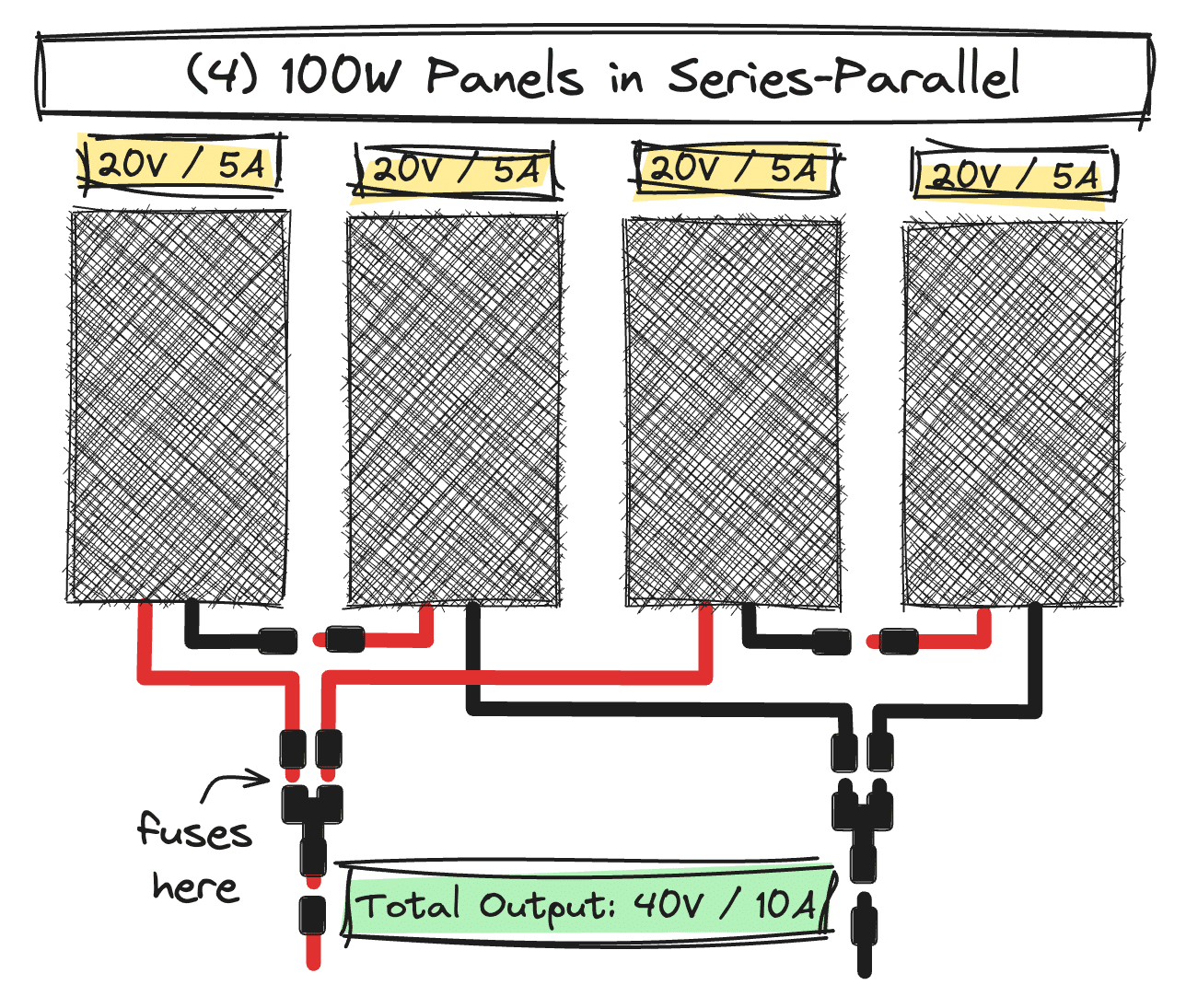
With a series-parallel connection, the voltages of the panels in the series strings add, then the current of the two strings in parallel adds.
Example: If you have four 100W solar panels wired in series-parallel (two series strings of 2 x 100W panels wired in parallel) and each panel outputs 5A at 20V, your array would output 10A at 40V (series string of 2 panels x 20V = 40V; 2 strings in parallel x 5A = 10A).
You need at least 400W of solar for a series-parallel connection, and each string must have the same number of panels. To increase the size of your solar array, you can either up the wattage of your series strings (i.e. two strings of 3 x 100W panels) or add more strings (i.e. three strings of 2 x 100W panels). Or both.
Personally, we would stick to series for solar panel arrays up to 400W, and consider splitting an array into two series-parallel strings for 600W or higher. This would ensure that the array voltage is high enough to really take advantage of the charging benefits.
Benefits of Series-Parallel Wiring for Solar Panels
With this hybrid solar wiring configuration, you’ll get the performance benefits of both series and parallel wiring.
- Increased voltage due to the series strings means your batteries will charge earlier, faster, and longer, and you’ll be making proper use of your MPPT charge controller.
- You can build a larger array without increasing voltage too much.
- Reduced effects of shade because you have multiple strings that are unaffected by each other.
Drawbacks of Series-Parallel Wiring for Solar Panels
The primary drawback of series-parallel wiring is the increased complexity of planning and installing your camper solar energy system. You will need additional wiring connectors, and you will need to fuse each of your strings.
Series-parallel is also best used for larger setups. While you can employ series-parallel with as little as 400W of solar, the bigger benefits really kick in when you have 600W or more.
Important Note: If you’re thinking about using series-parallel wiring, make sure to review our recommendations for fusing solar panels. You will likely need to fuse every individual string of a series-parallel array at the positive wiring connector.
Series vs Parallel for Mismatched Solar Panels
While it’s ideal to use identical solar panels no matter the wiring method, sometimes that’s not an option. Maybe you’re expanding the capacity of an existing solar array and you can’t find exact matches for your original panels. Or maybe you just want to make use of random solar panels you already have laying around.
Luckily, it is possible to wire together different solar panel types that have mismatched sizes, different electrical ratings, or are from different manufacturers.
The key to deciding between parallel or series wiring for mixing panels lies in what happens to the voltage and current in each wiring scheme.
When you’re wiring mismatched solar panels in series, you want to use panels with the same current rating (or similar). Remember, for series wiring, output voltages add while current stays the same. So with mismatched panels, all the panel voltages would still add together, but the output current of the series string would be equal to the solar panel with the lowest current rating.
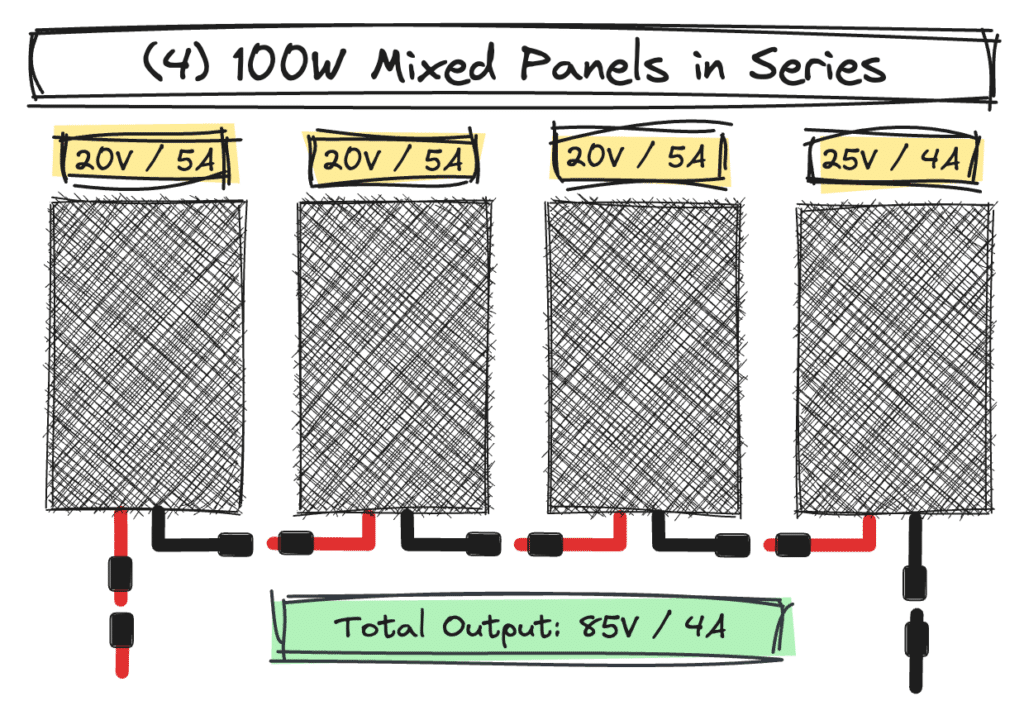
Example: You have four mismatched 100W solar panels wired in series. Three of the panels output 5A at 20V, while the fourth panel outputs 4A at 25V. The output of the entire array would be 4A at 85V (20V + 20V +20V + 25V = 85V. Lowest current rating = 4A).
Put another way, if you’re wiring together solar panels with a similar current rating but different voltages, we recommend parallel wiring vs series or series-parallel.
When you’re wiring mismatched solar panels in parallel, you want to use panels with the same voltage rating (or similar). Remember, for parallel wiring, Amps add while Volts stay the same. So with mismatched panels, all the amperages would still add together, but the output voltage of the array would be equal to the solar panel with the lowest voltage rating.
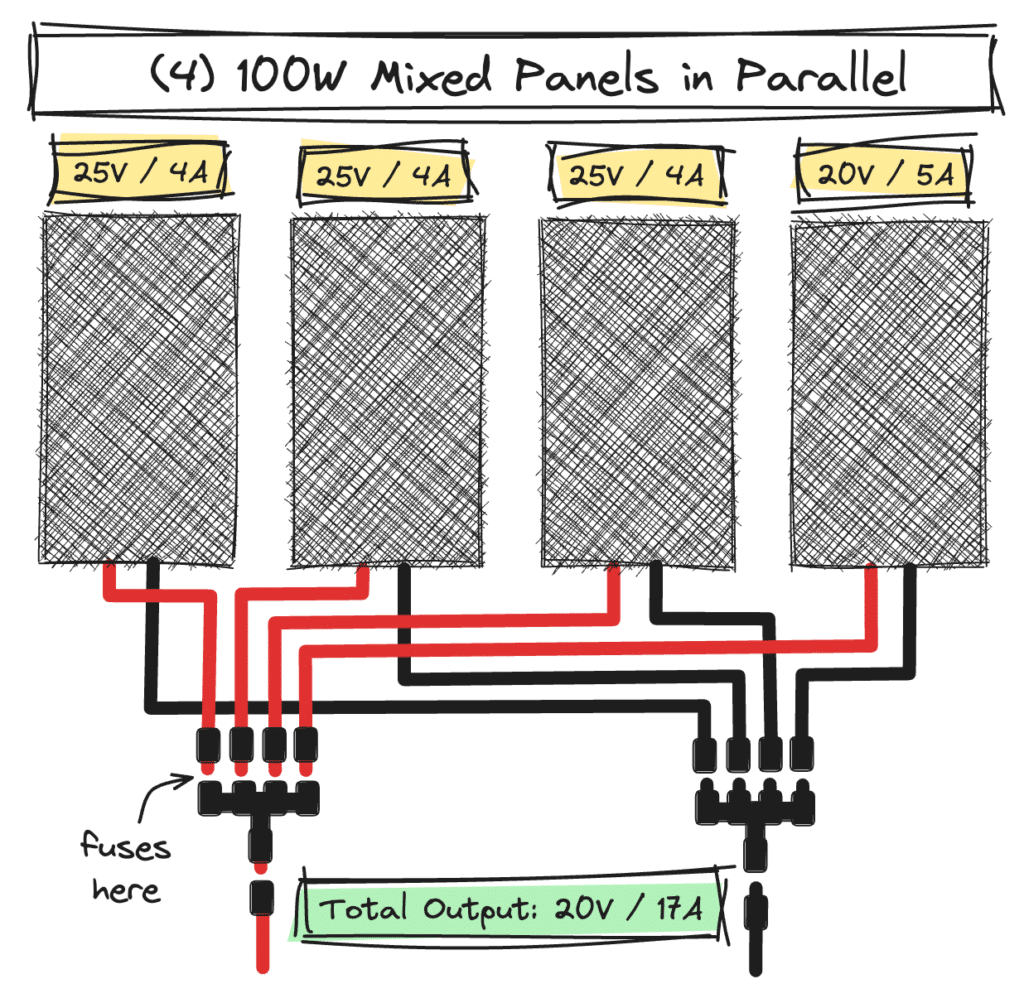
Example: You have four mismatched 100W solar panels wired in parallel. Three of the panels output 4A at 25V, while the fourth panel outputs 5A at 20V. The output of the entire array would be 17A at 20V (4A + 4A +4A + 5A = 17A. Lowest voltage = 20V).
So if you’re wiring solar panels with similar voltages but different current ratings, we recommend series wiring vs parallel.
The above guidelines can help you cobble together a solar system using multiple solar panels with different electrical ratings. However, if you’re expanding an existing system with different panels, consider wiring them to an additional solar controller instead. You’ll get the most out of your electrical system if all the same panels are feeding into each charge controller.
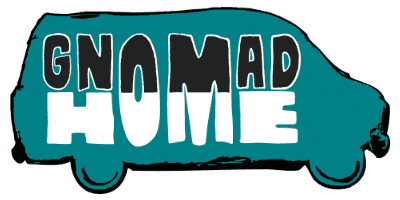



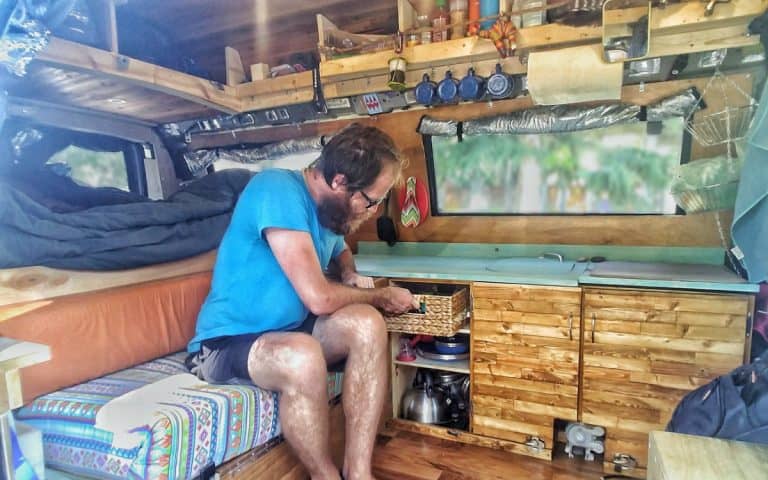
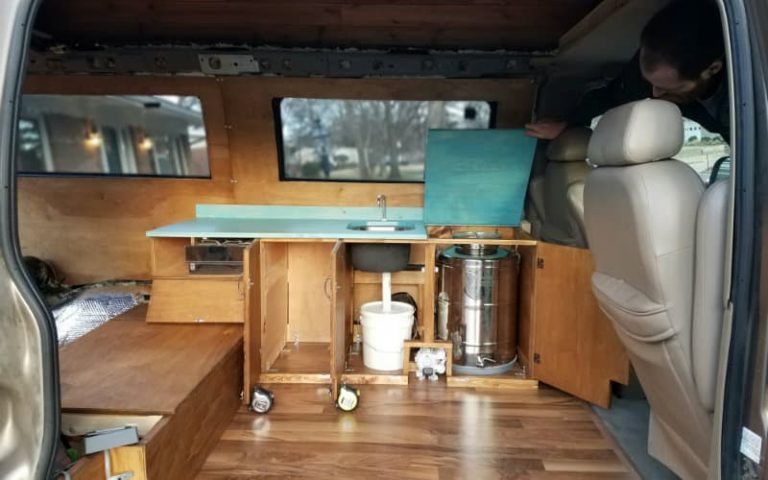

Hi John, I have no idea of how to wire up my 4 x 180w mono solar panels. I was thinking of series parallel in 2 circuits.
Hi Ricky, Series-Parallel would be a good choice with that setup. You would get the voltage increase for two panels in series, and have two independent strings that will help with shading.